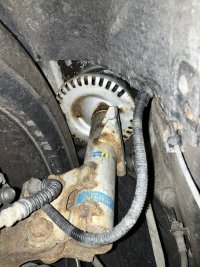Ok, I knew I was lowered but didn’t know the details (I know…I just liked the general vehicle And she was super low mileage and a fair bargain for loaded spec!). The dealer mentioned new 30mm lowering springs - sourced from Leighton’s. Possibly H&R? My ride height is about 395mm (wheel centre to top of wheel arch).
Ride is perhaps a little firm but good/sporty. Handles very well.
I’ve finally managed to get a better look underneath (thanks to my unfortunate undercarriage plastic tray damage!) - pics below.
Clearly some Bilstein shocks… but are these Bilstein B14s or do I just have Bilstein shocks (B4 or 6??) and coils???
General details: 2019 T6 LWB Kombi T32 204PS DSG 4mo. 20” alloys on 275/35/R20s [footnote 1].
Are Bilstein B14s even suitable for T32 4mo? Due to load rating?
Footnote 1:
Yes 275/35/R20s are 102 load rated but, despite being T32, the doorplate has a confusing 102/104 quoted! My understanding is that a Kombi isn’t a class 7 so moot - at least from an MoT perspective.


Ride is perhaps a little firm but good/sporty. Handles very well.
I’ve finally managed to get a better look underneath (thanks to my unfortunate undercarriage plastic tray damage!) - pics below.
Clearly some Bilstein shocks… but are these Bilstein B14s or do I just have Bilstein shocks (B4 or 6??) and coils???
General details: 2019 T6 LWB Kombi T32 204PS DSG 4mo. 20” alloys on 275/35/R20s [footnote 1].
Are Bilstein B14s even suitable for T32 4mo? Due to load rating?
Footnote 1:
Yes 275/35/R20s are 102 load rated but, despite being T32, the doorplate has a confusing 102/104 quoted! My understanding is that a Kombi isn’t a class 7 so moot - at least from an MoT perspective.





